AETIOLOGICAL FACTORS OF GRADE-III PROTEIN-CALORIE MALNUTRITION AMONG ADMITTED CHILDREN IN A TERTIARY CARE HOSPITAL
DOI:
https://doi.org/10.69656/pjp.v19i4.1560Keywords:
Grade 3 PCM, Severe acute malnutrition, SAM, primary PCM, PCM, Protein Calorie MalnutritionAbstract
Background: Aetiological factors of Protein-Calorie-Malnutrition (PCM) in underdeveloped countries are an established fact. An increase in number of children with grade-III PCM secondary to myriad of reasons has been noted recently. This study aimed to recognize the aetiological factors of grade-III PCM among admitted patients of grade-III PCM in Ayub teaching hospital Abbottabad. Methods: Severe acutely malnourished (SAM) children 6?60 months of age were selected following non probability random sampling technique. The chosen patients were selected according to WHO criteria of PCM grade-III. Primary data was collected from patients admitted to inpatient facility, on a questionnaire from patients whose anthropometric measurements fell under the criteria of severe acute malnutrition (SAM) by WHO during their hospital stay. Results: Higher number of SAM children was due to reversible aetiological factors like inaccessible food, inadequate breast-feeding and weaning practices, and improper food choices for weaning, illiteracy, ignorance, poor sanitation and large family sizes that led to SAM. From 100 patients (52 males), primary malnutrition was the most common cause for grade -III PCM present in 45 patients (23 females). Conclusion: Primary malnutrition was the main aetiological factor for grade-III PCM, more common among females, perhaps due to cultural issues in our region. It was also the main contributing cause in the toddler age group.
Pak J Physiol 2023;19(4):39–41
Downloads
References
World Health Organization (WHO). Malnutrition. https://www.who.int/news-room/fact-sheetworldwide.s/detail/ malnutrition.
De Onis M, Blössner M. WHO global database on child growth and malnutrition. Geneva: WHO; 1997.p 1–67. Available from: https://citeseerx.ist.psu.edu/pdf/ 97232c7bba5bef3ac970bf82966a8ea97cb4fa14
UNICEF. National nutrition survey 2018 –KFR. Available from: https://www.unicef.org/pakistan/national-nutrition-survey-2018
Casadei K, Kiel J. Anthropometric Measurement. 2022 Sep 26. In: StatPearls [Internet]. Treasure Island (FL): StatPearls Publishing; 2023 Jan. PMID: 30726000.
Saunders J, Smith T. Malnutrition: causes and consequences. Clin Med (Lon) 2010;10(6):624–7.
Abera SF, Kantelhardt EJ, Bezabih AM, Gebru AA, Ejeta G, Lauvai J, et al. Nutrition specific and sensitive drivers of poor child nutrition in Kilte Awlaelo-Health and Demographic Surveillance Site, Tigray, Northern Ethiopia: implications for public health nutrition in resource-poor settings. Glob Health Action 2019;12(1):1556572.
Hossain A, Niroula B, Duwal S. Ahmed S, Kibria MG. Maternal profiles and social determinants of severe acute malnutrition among children under-five years of age: a case-control study in Nepal. Heliyon 2020;6(5):e03849.
Jena P, Rath S, Nayak MK, Satapathy D. Study of social and demographic determinants of severe acute malnutrition in children aged 6?59 months in a tertiary care centre of Odisha, India. Int J Contemp Pediatr 2019;6(1):46–51.
Anato A. Severe acute malnutrition and associated factors among children under-five years: A community based-cross sectional study in Ethiopia. Heliyon 2022;8(10):e10791
Kim SY, Yi DY. Components of human breast milk: From macronutrient to microbiome and microRNA. Clin Exp Pediatr 2020;63(8):301–9.
Gamit VD, Gohil JR, Nikhileshwar AB, Vagh TP. Etiological factors of severe acute malnutrition and impact of nutrition rehabilitation centre: a prospective observational study from Bhavnagar. Int J Contemp Pediatr 2021;8(4):652–8.
Iyengar A, Raj JM, Vasudevan A. Protein energy wasting in children with chronic kidney disease and end-stage kidney disease: an observational study. J Ren Nutr 2021;31(3):270–7.
Downloads
Published
How to Cite
Issue
Section
License

This work is licensed under a Creative Commons Attribution-NoDerivatives 4.0 International License.
The author(s) retain the copyrights and allow their publication in Pakistan Journal of Physiology, Pak J Physiol, PJP to be FREE for research and academic purposes. It can be downloaded and stored, printed, presented, projected, cited and quoted with full reference of, and acknowledgement to the author(s) and the PJP. The contents are published with an international CC-BY-ND-4.0 License.











